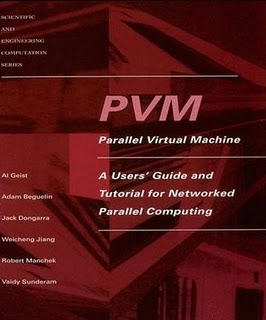
|
FreeComputerBooks.com
Links to Free Computer, Mathematics, Technical Books all over the World
|
|
- Title: PVM: Parallel Virtual Machine: A Users' Guide and Tutorial for Network Parallel Computing
- Author(s) Al Geist, Adam Beguelin, Jack Dongarra, Weicheng Jiang, Robert Manchek, Vaidyalingam S. Sunderam
- Publisher: The MIT Press
- Paperback: 299 pages
- eBook: HTML and PDF
- Language: English
- ISBN-10: 0262571080
- ISBN-13: 978-0262571081
- Share This:

|
Written by the team that developed the software, this tutorial is the definitive resource for scientists, engineers, and other computer users who want to use PVM to increase the flexibility and power of their high-performance computing resources.
This book introduces distributed computing, discusses where and how to get the PVM software, provides an overview of PVM and a tutorial on setting up and running existing programs, and introduces basic programming techniques including putting PVM in existing code. There are program examples and details on how PVM works on UNIX and multiprocessor systems, along with advanced topics (portability, debugging, improving performance) and troubleshooting.
PVM (Parallel Virtual Machine) is a software package that enables the computer user to define a networked heterogeneous collection of serial, parallel, and vector computers to function as one large computer. It can be used as stand-alone software or as a foundation for other heterogeneous network software. PVM may be configured to contain various machine architectures, including sequential processors, vector processors, and multicomputers, and it can be ported to new computer architectures that may emerge.
About the Authors-
George A. Geist II is Research Scientist at Oak Ridge National Laboratory. Adam Beguelin is Research Computer Scientist in the School of Computer Science at Carnegie Mellon University. Jack Dongarra is Distinguished Scientist, Weicheng Jiang is Research Associate, and Robert Manchek is Senior Research Associate in the Department of Computer Science at the University of Tennessee. Vaidyalingam S. Sunderam is Associate Professor in the Department of Mathematics and Computer Science at Emory University.
- Parallel Computing and Programming
- Network and Distributed Programming
- Algorithms and Data Structures
- Computational Complexity
 Similar Books:
Similar Books:
-
 The Practice of Parallel Programming (Sergey A. Babkin)
The Practice of Parallel Programming (Sergey A. Babkin)
This book provides an advanced guide to the issues of the parallel and multithreaded programming. It goes beyond the high-level design of the applications, into the details that are often overlooked but vital to make the programs work.
-
 Is Parallel Programming Hard? If So, What Can You Do About It?
Is Parallel Programming Hard? If So, What Can You Do About It?
It examines what makes parallel programming hard, and describes design techniques that can help you avoid many parallel-programming pitfalls. It is primarily intended for low-level C/C++ code, but offers valuable lessons for other environments as well.
-
 Data Parallel C++: Mastering DPC++ Programming
Data Parallel C++: Mastering DPC++ Programming
Learn how to accelerate C++ programs using Data Parallelism. This book enables C++ programmers to be at the forefront of this exciting and important new development that is helping to push computing to new levels.
-
 Pro TBB: C++ Parallel Programming with Threading Building Blocks
Pro TBB: C++ Parallel Programming with Threading Building Blocks
This book is a modern guide for all C++ programmers to learn Threading Building Blocks (TBB). It presents numerous examples and best practices to help you become an effective TBB programmer and leverage the power of parallel systems.
-
 Introduction to Parallel Computing (Blaise Barney)
Introduction to Parallel Computing (Blaise Barney)
This book explains how to design, debug, and evaluate the performance of distributed and shared-memory programs. It teaches students how to compile, run and modify example programs. It is a complete end-to-end source of information on almost all aspects.
-
 Notes on Theory of Distributed Systems (James Aspnes)
Notes on Theory of Distributed Systems (James Aspnes)
This book rovides a comprehensive source of material on the principles and practice of distributed computer systems and the exciting new developments based on them, using a wealth of modern case studies to illustrate their design and development.
-
 Distributed Systems, 3rd Edition (Maarten van Steen, et al)
Distributed Systems, 3rd Edition (Maarten van Steen, et al)
This book covers the principles, advanced concepts, and technologies of distributed systems in detail, including: communication, replication, fault tolerance, and security. It shows how distributed systems are designed and implemented in real systems.
-
 Introduction to High-Performance Scientific Computing (Eijkhout)
Introduction to High-Performance Scientific Computing (Eijkhout)
This is a textbook that teaches the bridging topics between numerical analysis, parallel computing, code performance, large scale applications. it assumes a basic knowledge of numerical computation and proficiency in Fortran or C programming.
-
 O'Reilly® Parallel and Concurrent Programming in Haskell
O'Reilly® Parallel and Concurrent Programming in Haskell
This hands-on book shows you how to use the language’s many APIs and frameworks for writing both parallel and concurrent programs. You'll learn how parallelism exploits multicore processors to speed up computation-heavy programs.
-
 BIG CPU, BIG DATA: Solving the World's Toughest Problems
BIG CPU, BIG DATA: Solving the World's Toughest Problems
This book teaches you how to write parallel programs for multicore machines, compute clusters, GPU accelerators, and big data map-reduce jobs, in the Java language, with the free, easy-to-use, object-oriented Parallel Java 2 Library.
-
 Programming on Parallel Machines: GPU, Multicore, Clusters, etc.
Programming on Parallel Machines: GPU, Multicore, Clusters, etc.
The main goal of the book is to present parallel programming techniques that can be used in many situations for many application areas and which enable the reader to develop correct and efficient parallel programs.
-
 Parallel Computing Works! (Geoffrey C. Fox, et al.)
Parallel Computing Works! (Geoffrey C. Fox, et al.)
A clear illustration of how parallel computers can be successfully applied to large-scale scientific computations. This book demonstrates how a variety of applications were implemented on real parallel computers to produce new scientific results.





